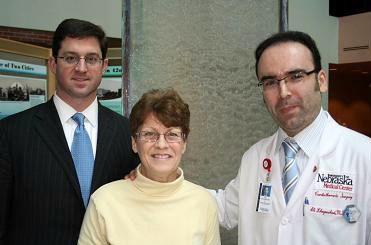 |
Mary Kraft recently underwent a rare aortic dissection surgery at UNMC’s hospital partner, The Nebraska Medical Center. The surgery was performed by Matthew Longo, M.D., left, and Ali Khoynezhad, M.D., Ph.D. |
“It was an all-consuming pain,” she said. “The worst I’d ever felt.”
Kraft’s husband took her to the emergency room. It didn’t take doctors there long to realize what was causing Kraft’s pain — aortic dissection, a tear in the body’s largest blood vessel that can lead to an aortic rupture and instant death.
Later the night of her emergency room visit in Grand Island, Kraft was rushed to a Lincoln hospital, and then on to The Nebraska Medical Center — UNMC’s hospital partner.
That’s where Matthew Longo, M.D., vascular surgeon at The Nebraska Medical Center and assistant professor of surgery at UNMC, and Ali Khoynezhad, M.D., Ph.D., assistant professor of cardiovascular and thoracic surgery at UNMC and cardiothoracic and endovascular surgeon at The Nebraska Medical Center, evaluated Kraft for an endovascular stent graft and determined she was a good candidate.
Surgeons performed the operation on Jan. 23, one week after her visit to the Grand Island emergency room.
“Only 10 or 15 medical centers in the U.S. are able to offer this procedure,” Dr. Khoynezhad said.
In the stent graft operation, surgeons introduce a stent through the femoral artery in the leg and then place it in the damaged part of the aorta. It is an alternative to a much riskier open surgery. Thirty percent of patients do not survive the open surgery; 10 percent of those who do survive have a stroke, another 10 percent become paralyzed below the waist.
“You’re dealing with some very high-priced real estate so to speak,” Dr. Longo said in describing the open surgery. “Blood flow to the brain and other major organs is the concern. It’s like trying to sew two pieces of tissue paper together.”
Most people who have aortic dissection die from it. It’s the condition that took the life of actor John Ritter in 2003.
“It’s about 100 times deadlier than a heart attack,” Dr. Khoynezhad said. “Therefore, if one comes to the hospital with chest pain, one would hope it’s a heart attack and not an aortic dissection.”
Only 40 percent of people with the condition make it to the hospital alive. Kraft feels fortunate not only because she was lucky enough to survive, but because Drs. Longo and Khoynezhad repaired her dissection without the risk of open surgery and the lengthy recovery period. Two days after her operation, she walked out of the hospital.
|
|
“Most stents are used currently to repair aneurysms,” Dr. Khoynezhad said. “That will change in the near future as the long-term data supporting the use of stent graft in type B aortic dissection becomes more evident. In the next few years, surgeons will more frequently offer stents to repair dissection.”
The Nebraska Medical Center opened its vascular center in August of 2007 with the goal of forming a center that could treat all parts of the circulatory system. By combining the skills of physicians with different vascular expertise, including minimally invasive and endovascular procedures, the hospital can offer a new and more comprehensive approach to patient care.
“Endovascular operations are a huge area of growth,” Dr. Longo said. “That’s something special about the new vascular center here. You have doctors with different specialties working together to treat very, very serious conditions.”